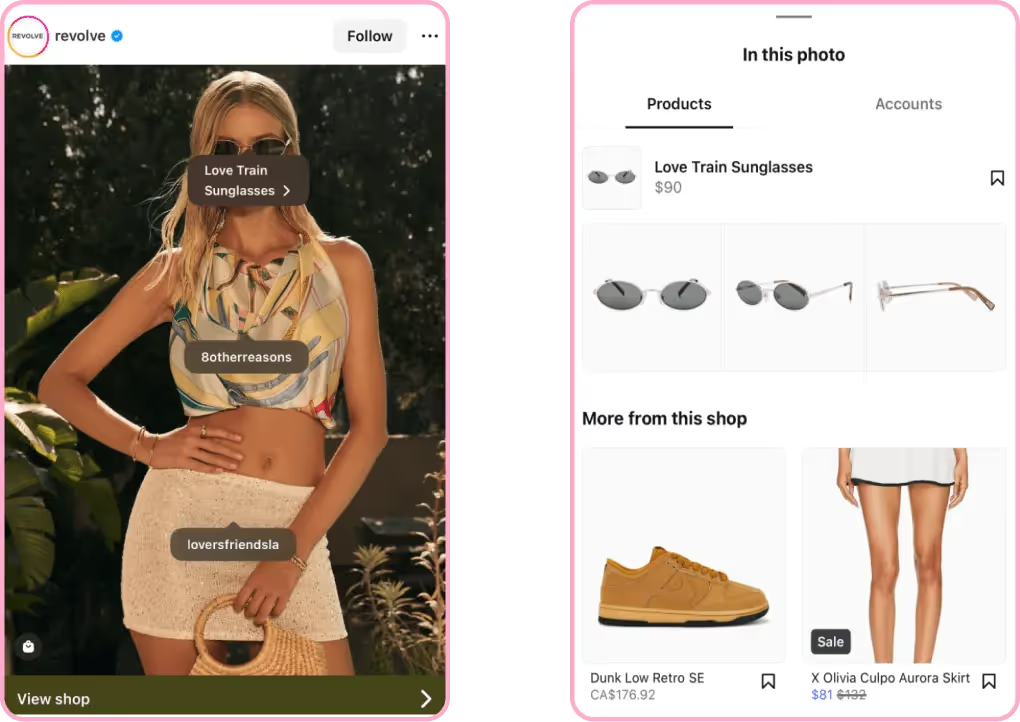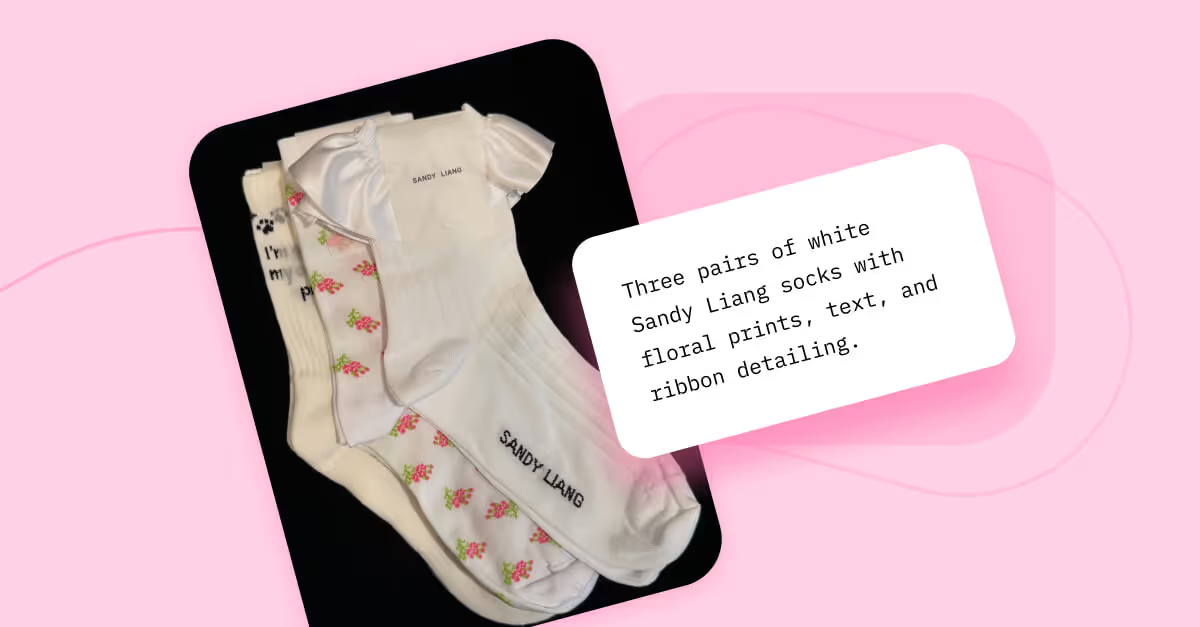How Social Data Powers Smart In-Store Strategies for Retail
The key to omnichannel success? A strategy that syncs every touchpoint.

The strongest marketing strategies aren’t just digital or physical; they’re both. Since consumer behavior spans apps, various social feeds, storefronts and everything in between, brands need to focus on meeting people wherever they are. That’s where omnichannel marketing comes in.
Omnichannel strategies bring consistency to customer experiences across all platforms. It’s important to remember that omnichannel strategies aren’t about being everywhere; they’re about being connected where it matters most. Omnichannel strategies can help align what happens on social with what happens in-store, via email or during events. For social media managers, this means thinking about the full customer journey and making sure each point reinforces the other.
Balancing online and offline strategies helps brands build familiarity, trust and action. A customer might see a sweater on Instagram, visit a store to try it on and then see a retargeted ad with an offer to purchase online. Each step works together, and brands that can understand how to use digital insights to enhance their in-person experience (and vice versa) are the ones that stay relevant and top of mind.
TL;DR
- Omnichannel retail connects online and offline channels to create one seamless shopping experience
- Customers expect consistency across touchpoints, from social posts to in-store visits to follow-up emails
- Social media plays a crucial role in driving discovery, engagement, conversion and loyalty
- A strong strategy uses data to personalize experiences and remove friction at every stage
- Leading brands are investing in social commerce, in-store tech and integrated customer data to stay competitive
What Is an Omnichannel Retail Strategy?
An omnichannel retail strategy connects all the ways customers can shop with a brand into one seamless experience. Rather than treating each channel in a silo, this strategy brings online and offline activities together to craft a consistent customer journey, regardless of where it starts.
These channels include shopping in-store, on a brand’s website, through mobile apps, social media platforms, third-party marketplaces and even conversational commerce like customer service chats. They also cover curbside pickup, buying online and picking up in-store (also known as BOPIS) and using QR codes in physical spaces to drive online engagement or provide essential communication.
Here’s a glimpse at what omnichannel retail industry tactics can look like:
The goal of an omnichannel retail strategy is to give shoppers flexibility and convenience while making sure each interaction feels on-brand and informed by what stage came before. A shopper might browse products on Instagram, add something to their cart via mobile and then finish the purchase in-store. With omnichannel strategies in place, each of these steps is connected and optimized to drive conversion.
Why Invest in an Omnichannel Retail Strategy?
Customers don’t think in channels. They browse on social, DM their friends about interesting products or services, check prices and sales online, swing by the store on their way home from work and maybe even make a post about what they bought on social media. This is why brands can’t afford to treat in-store and digital experiences separately, everything must work together for a tailored, effective and informed retail strategy.
An omnichannel retail strategy helps brands create smoother and more connected customer journeys. When each touchpoint aligns, you benefit by receiving better customer data. You can easily see what works, what doesn’t, and where people drop off during the buying journey, so you can improve the path to purchase and build a brand experience consumers are excited to participate in.

Ready to Nail Your Omnichannel Strategy?
We’ve packed everything you need to enhance your omnichannel strategy into one easy guide — no fluff, just results.
Download the Guide5 Steps To Build an Omnichannel Retail Strategy
The strongest strategies start with a clear understanding of your customer and building consistent, connected experiences across each shopping channel. From customer segmentation to which social media marketing tools you use, each step plays a crucial role in driving conversions.
1. Personalization and Targeted Marketing
Start by breaking down your audience into clear segments. Look at shopping habits, preferred channels, purchase frequency, and related interests. This allows you to personalize your content to match specific needs, interests and life milestones, like graduation, marriage, or buying a home. The more precise your segmentation, the more relevant your messaging becomes.
Why? → This step helps you uncover insights about consumer preferences, behaviors, and trends; letting you deliver tailored product recommendations, offers, and communication. This level of personalization boosts engagement and drives conversions both online and in-store.
2. Leverage Real-Time Feedback and Behavioral Analytics
Next, tap into social media listening tools and online monitoring tools to understand which products and trends your audience engages with. Social media monitoring captures customer feedback, reviews, and sentiment in real time. This data helps retailers adjust in-store promotions, product assortments, and service strategies to become more dynamic and better meet customer’s expectations and improve overall satisfaction.
Why? → Online data can inform various aspects of the in-store experience. Are you a food retailer and see your audience engaging with a specific food trend (remember the viral Emily Mariko salmon bowl?) Some grocery stores saw their audience engaging with this trend and were actively seeking the ingredients to replicate it. They responded with featured displays grouping the necessary products together and making them as visible and accessible as possible. With an understanding of what your customers are looking for, you can determine the best end-caps to feature in-store, products to order and even what types of in-store activations will resonate with local customers the most.
3. Map Customer Journey
Plot out each step a customer might take from initial brand awareness all the way to repeat purchases. This includes all possible touchpoints: organic discovery, traditional and social media advertising, website visits, in-store experiences and ongoing communication.
Why? → Mapping the ideal customer journey gives you a clearer view of how people interact with your brand, helps remove friction, maintains consistent messaging, and finds opportunities to add value. Ensuring every touch point is intentional.
4. Diversify Shopping Touchpoints
Diversifying shopping touchpoints makes it easy for people to shop wherever they are. Use product tags on social media posts, link-in-bio tools to direct users to specific product pages, shoppable galleries embedded in your LikeShop profile and email marketing and store locator features.
Why? → While mapping the buyer journey is important, a customer might be ready to purchase online, in-store and even on social media. Simplifying this process helps drive conversions whenever the customer is ready to buy, on the platform they prefer shopping on most.
5. Explore Product Integrations
Connecting offline and online efforts can be challenging, but it’s easy with the right social media management tools integrated in your tech stack. Having your offline and online systems communicate with each other helps keep experiences consistent and gives your team a level of control and insight into potential changes. Examples of these integrations include integrating your POS system with social campaigns, using a CRM that tracks behavior across each channel, which helps your entire marketing ecosystem stay agile.
Why? → Let’s say you receive feedback from in-store staff that customers are consistently calling to ask if a product they saw online is in stock, while your web team notices users dropping off the same product page. By integrating store inventory, your in-store team can have valuable time back in their day, and your digital team can ensure customers have their questions answered during the consideration or purchasing phase.
Omnichannel Retail Strategy Tips
Ensuring your digital and physical retail strategies align creates a shopping experience that feels smooth and personal, no matter where it happens. Once your channels are in place, continually optimizing how they work together makes all the difference.
Here are some tips to help strengthen your approach:
Create a Seamless Shopping Experience
Customers should be able to move from social to site to store without confusion or friction. Keep branding consistent, make navigation intuitive and ensure that promotions, pricing and product info align across every touchpoint. The fewer surprises, the better the conversion.
Prioritize Inventory Transparency
Nothing disrupts trust faster than out-of-stock products or unclear availability. Let customers see what’s in stock in their local store, enable pickup or delivery options in real time and sync inventory across platforms. This helps keep expectations clear and avoids disappointment.
Leverage Data To Personalize Across Channels
Use metrics from social media analytics tools that speak to consumer habits, browsing patterns and purchase history to shape the shopping experience. This can look like recommending similar or related products in follow-up emails, retargeting based on category interest and personalizing in-app messaging or emails to reflect where a customer left off — think reminders of carts left unpurchased, sale notifications for items on their ‘liked’ lists and text-message discount codes.
Unify Customer Support Across Channels
Make it easy for customers to get help wherever they need it: in DMs, in-store, via chatbot or by phone. Connect your support tools so every rep has the full context of a customer’s interactions, no matter where they happened. Fast, helpful support builds trust and encourages repeat business. AI and automation take this even further: AI-powered chatbots on social platforms can instantly answer questions, offer tailored product recommendations and guide customers from social engagement to in-store purchases, all while maintaining consistent, loyalty-building service.
Drive Foot Traffic With Localized Marketing
Social media platforms allow businesses to reach people in specific areas through location-targeted ads and posts, making it easier to attract local customers to their stores. By sharing area-specific content and encouraging user-generated posts from nearby shoppers, businesses can boost visibility and drive more foot traffic.
Omnichannel Retail Trends
As shopping habits shift, brands find new ways to connect digital and in-store experiences. A brand’s focus shouldn’t be on showing up absolutely everywhere; it should be on showing up where it matters most.
Full-Funnel Social Commerce
Social platforms aren’t just for discovery anymore. From product tags to in-app checkout and live shopping, more customers are completing their entire purchase journey without leaving the app. Brands are using social commerce to both inspire and convert, all within a single scroll.

Designer clothing retailer Revolve is an excellent example of taking a full-funnel approach to conversions. While the brand taps into social media ads and out-of-store experiences like brand trips for creators and influencer marketing, they make it easy to find inspiration and make a purchase directly from Instagram. Take the example above: in their caption, they share a trend for the user to partake in, in this case, scarf tops. In the image, they link to the brands featured and include product tags for the sunglasses, so users can see other brands and shop the image from one convenient tab.
In-Store Tech That Mirrors Online Behaviour
Retailers are bringing digital behaviors into physical spaces. Think QR codes for product details, self-checkout tied to loyalty apps and digital displays that adapt based on shopper data. These tools help create a more connected, familiar experience in-store.

World-leading sports brand Nike recognized the value of in-store technology, pairing it with community-based marketing to provide a more personalized customer experience. After seeing a 41% spike in online sales, Nike launched its ‘Nike Live’ stores in 2018, a concept store that aims to combine its digital offerings with an in-store experience, with a special focus on catering to local communities.
Its first location, ‘Nike by Melrose’, was not just located on Melrose Avenue in West Hollywood, but featured products that people in the community purchase most often. They gathered this data with shopping patterns on their website and Nike Plus users. Other ‘digital’ features include an online shoe try-on reservation (easily accessed with lockers), smart fitting rooms that let you change a size, color or style without leaving (and have an employee bring it to you) and the ability to access in-store footage (like their treadmill test for sneakers) and share it on your personal social media account.
Nike is a trailblazer for introducing in-store tech that mirrors online behavior, using data-driven personalization to create a seamless path from browsing online to purchasing in-store.
Unified Customer Data, Smarter Personalization
Brands are investing in platforms that centralize data from every channel: online, in-store, mobile and social. With one source of truth for customer information, brands can deliver more relevant offers, recommendations and support wherever people shop.
Beauty retailer Sephora is a great example of unifying customer data for more innovative personalization. Sephora’s digital CRM links in-store purchases of individuals with a Sephora account — encouraged with points and free, annual birthday gifts — and uses this data to provide valuable communication to the customer, so they don’t feel bombarded with sales content. This looks like reminders for products that are back in stock, ads tailored to similar products they’ve purchased in the past (in-store or online) and email suggestions for offers based on purchase history.
Brands should build connected omnichannel experiences to improve digital marketing and in-store service. This starts with analyzing social data to understand what drives engagement, discovery and purchases, then applying your insights to in-store tactics like product availability, displays and promotions. A tech stack that includes unified customer data boosts your ability to personalize the experience for customers and encourage online inspiration to move in-store.
Omnichannel Retail Strategy FAQs
How does social commerce enhance personalized shopping experiences for consumers?
Social commerce uses real time data like online browsing habits and engagement to tailor product recommendations, promotions and online content to consumers. This creates a more relevant shopping journey that reflects customers’ preferences.
What future trends might further connect social data with in-store retail strategies?
In the future, brands can expect more robust integrations between POS systems and social analytics, leveraging AI to aid merchandising and in-store tech like QR codes and digital mirrors that respond to online habits.
What role do influencers play in driving social retail sales and customer trust?
Influencers help bridge discovery and purchase by showcasing products in authentic, relatable ways. Their content often builds trust, provides strong social proof and encourages purchases among followers. Micro and nano-influencers in particular are powerful due to their impact on niche communities and relationships with their followers.
Why is integrating e-commerce features within social platforms crucial for in-store retail success?
Integrating e-commerce tools like product tags, in-app checkout, and store locators within social platforms is crucial because it creates a seamless shopping experience and shortens the path to purchase. It also helps retailers track what resonates online to better tailor both online and offline experiences.






